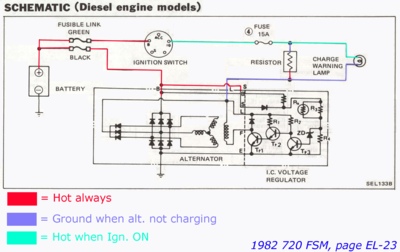

I wanted two, but the second one was a Spanish "model" with single lip only and the rubber was rather hard (probably an old stock).
Moderators: plenzen, Nissan_Ranger


No, and no.ecomike wrote: Any chance there is a thermal overload current overload protection in the alternator or its built in voltage regulator?
This could still be a wiring issue. The alternator isn't self-exciting. If it doesn't get voltage via the Ign. circuit (via the warning lamp), it won't turn on.. . . but then the voltage dropped off to about 12.5 V, so I guess I am screwed . . .

I've been operating on the assumption that it's a typo (the model No.).ecomike wrote:So why does the 1982 FSM for the 720 pick up show that diesel SD22 only came with the LR160? See page EL-25.
No. Well, since it's wired parallel to the idiot light, it's obvious that it provides more current to the voltage regulator when the key in ON, than the idiot light wattage would on its own.Can you elaborate on what the 20 ohm resistor does in the run to pin L?
I've never measured it. I would start with a one watt, and if it doesn't smoke, it was large enough. Though I'm guessing a half-watt resistor would do.Any idea what wattage it needs to be?
I hope that the L wire (color: WL) goes to your Charge (Alt) idiot light!I found a small wire that looks to be going to pin L that does not go directly to the battery. I have the three wires marked W on the wiring diagram that go from pin B directly to the battery, and what must be WL running L, but I don't know for sure where it comes from yet. I am guessing the ignition switch.
That schematic is a fragment, specific to the charging circuit. Fuse 4 feeds a lot more than just the charge idiot lamp.ecomike wrote:I find it curious that there is a 15 amp fuse listed in front of that resistor. Makes me wonder if 1 watt is anywhere near large enough for that resistor.
Scott must know something I don't. The lamp is a resistor, and the normal resistance of the lamp allows (on most of these older alternators) enough current to kick off the alternator. GM & Ford didn't use a parallel resistor, and neither does the LR160 version of this alternator. I'd bet it's there to solve some intermittant, one-percent problem that most of us will never see. If the idiot lamp works, I bet the LR150 starts up just fine without the extra resistor.Scott at the alternator shop told me that many newer vehicles have the resistor built into the light bulb itself.
No, I've seen what I think may be the resistor on the left fenderwell of a couple of early 720 diesels. I just haven't taken the time to confirm it.Makes me wonder if Nissan might not have already been doing that in 82.
I want to see you use an SCR with DC input to do phase-chopping output to 12v fans! I really do!I picked up a standard AC SCR dimmer/ceiling fan variable speed controller / switch today, 600 watt, that I plan to use for speed and power usage control of the AC condenser fan, it should help me drop the power load on the alternator some. Even though they are sold for AC, 120 volt devices, IIRC they also work on DC in DC out DC motor loads as I used one for DC battery charging research once.
I no longer have the schematic for the system I installed in my '83 G30, in 1994, but you will need to use an A/C high-side pressure switch (cheap, at any large A/C repair center) to toggle your fans to get idle fan control. That's what I did, it worked a charm. I had custom-engraved LED panel indicators (the lenses were engraved, very cool) made to tell me when the fans were on because of the A/C pressure switch, or if they were one because of thermostat demand. I added a third engraved indicator that read "A/C cycling switch" to let me know when the compressor was running too. I was pretty proud of that.I also bought an aftermarket bulb and capillary variable control thermal switch that I am going to use to cycle the AC condenser fan, as I probably only need it at idle, and for extended idling in heaving traffic.
I am not an EE either, sometimes wish I was, but I get pretty deep into parts of it at times. You lost me with the phase chopping comment. Are you suggesting I need something like a diode and capacitor on the output side of the SCR to stabilize the load?I want to see you use an SCR with DC input to do phase-chopping output to 12v fans! I really do!
You know something I don't.ecomike wrote:I do know it will drop the output DC voltage (from an input DC voltage) . . .
As the input to a battery charger, AC input, yes. I've used a phase-chopper (SCR) on the input of a marine power supply to create a variable-rate battery charger, and on an unsophisticated (old) battery charger with a linear power supply (a transformer, not a Switch Mode Power Supply), an SCR works OK.We used them for variable voltage output from a 12 volt battery charger input . . .
Users browsing this forum: No registered users and 1 guest